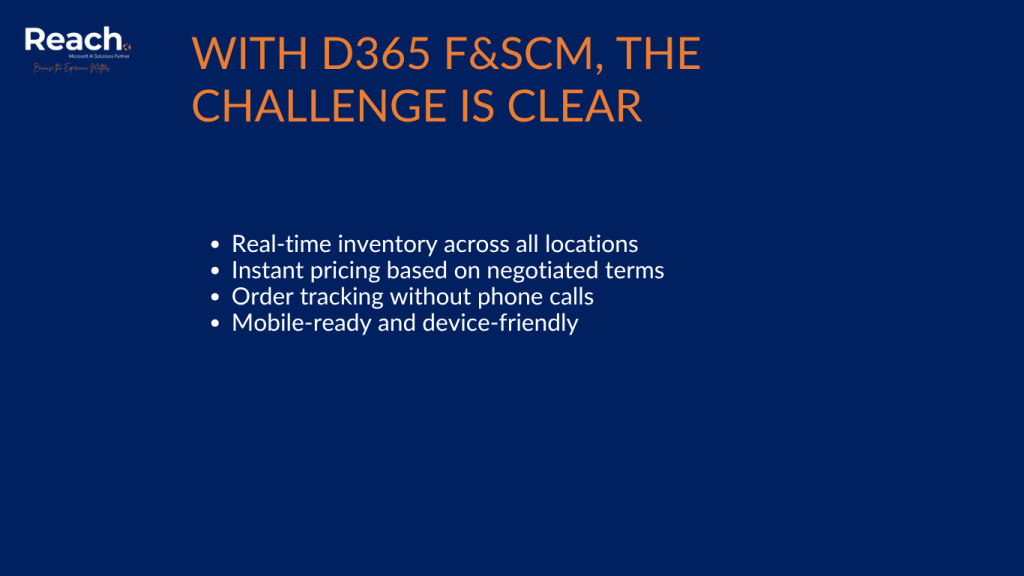Organizations running Dynamics 365 Finance and Supply Chain face a persistent challenge: their sophisticated ERP system implementation handles complex business processes beautifully internally but creating customer-facing experiences that leverage that same sophistication has traditionally required expensive custom development or clunky third-party solutions.
Modern B2B customers expect seamless digital experiences similar to what they encounter in consumer applications. They want real-time visibility into inventory, instant access to their negotiated pricing, and the ability to place orders without phone calls or email exchanges. Yet most D365 F&SCM implementations leave customers stuck with outdated interaction methods that don’t reflect the system’s underlying capabilities.

The Real Problem
The challenge isn’t simply about building a website where customers can place orders. Today’s business customers expect sophisticated functionality delivered through intuitive interfaces:
- Real-time inventory visibility across multiple locations
- Instant pricing calculations that respect their negotiated terms
- Order tracking without making phone calls
- Mobile-friendly interfaces that work seamlessly across devices
For D365 F&SCM organizations, this creates a fundamental dilemma. The data and business rules exist within the ERP, but accessing them requires either exposing complex internal interfaces to customers (definitely not user-friendly) or duplicating business logic in separate systems (a maintenance nightmare).
Consider the complexity involved: a single product price in D365 F&SCM might depend on customer agreements, volume discounts, regional pricing, promotional offers, and currency conversions. Recreating this logic outside the ERP system implementation isn’t just difficult – it’s a recipe for inconsistency and errors.
Why Traditional Solutions Fall Short with ERP System Implementation
Most portal solutions take one of two problematic approaches. Either they create a simplified front-end that lacks the sophistication customers need, or they attempt to replicate ERP functionality externally, leading to synchronization issues and conflicting data.
Many companies invest significant resources in custom portals that seem promising initially but become increasingly difficult to maintain as business rules evolve. Every change in D365 F&SCM requires corresponding updates in the portal, creating a dual-maintenance burden that ultimately makes the solution more expensive than the problem it solved.
| Approach | Benefits | Drawbacks |
| Simplified Portal | Quick to implement, Lower initial cost | Limited functionality, Poor customer experience, Doesn’t leverage ERP investment |
| Custom Integration | Full functionality possible, Complete control | High development cost, Maintenance complexity, Dual-system updates required |
| Third-party Solutions | Pre-built features, Vendor support | Limited D365 F&SCM integration, Additional licensing costs, Data synchronization issues |
| Power Pages + Dual Write | Native Microsoft integration, Real-time data sync, Low-code development | Requires D365 F&O knowledge, Initial learning curve |
Many companies invest significant resources in custom portals that seem promising initially but become increasingly difficult to maintain as business rules evolve. Every change in D365 F&SCM requires corresponding updates in the portal, creating a dual-maintenance burden that ultimately makes the solution more expensive than the problem it solved.
The Vision
What if customers could access the full power of your D365 F&SCM system through an interface designed specifically for them? What if pricing calculations, inventory checks, and order processing could happen in real-time using the exact same business logic your internal team relies on?
This vision requires more than just connecting a website to a database. It demands a fundamental shift in how we think about the relationship between ERP system implementation and customer experience platforms.
Ready to Transform Your Customer Experience?
At Reach, we’ve helped organizations bridge the gap between sophisticated D365 F&SCM capabilities and modern customer expectations. If you’re tired of manual order processing and want to give your customers the digital experience they deserve, let’s talk.
Contact us to discuss how Power Pages and Dual Write can transform your customer relationships while leveraging your existing D365 F&SCM investment. Our team brings deep expertise in both Microsoft technologies and customer experience design.
In Part 2, we’ll dive deep into the technical architecture that makes this transformation possible.

